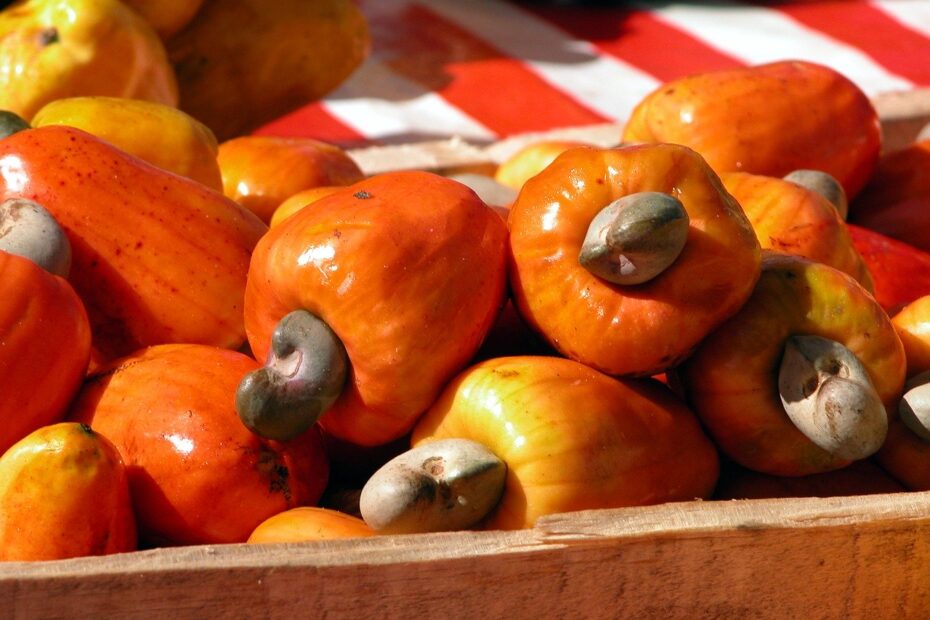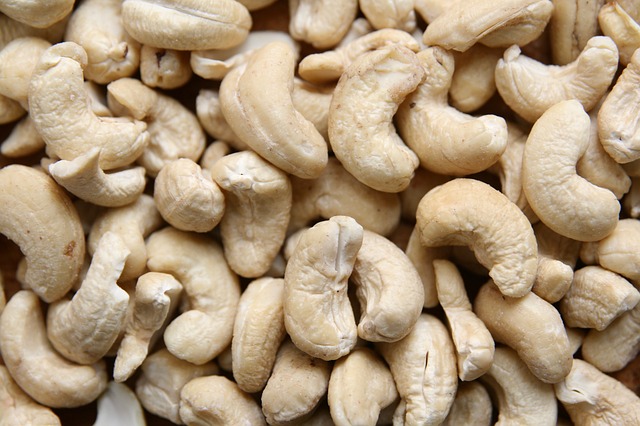Import Cashew Nuts
Import Cashew Nuts , Anacardium occidentalie Linn, are a plant of Dicotyledoneae , Asparagaceae , Anacardiaceae, and Cashew . Also known as cassava tree, chicken cashew nut, Jieshou fruit.
Evergreen trees with upright trunks up to 10 meters high. Cashew nuts are a kind of kidney-shaped nut , and are not of the cashew nut genus Anacardiaceae . Native to the Americas.
Cashew nuts are rich in nutritional value and can be used for cooking or medicinal purposes.
Its edible part is a kidney-shaped part born at the top of the fake fruit,
about 25 mm long, from blue-grey to yellow-brown (if the color is white when it is selected, it may be
Cashew Morphological characteristics
Shrubs or small trees, 4-10 meters high; branchlets yellow-brown, glabrous or nearly glabrous. Leaves leathery, obovate, 8-14 cm long, 6-8.5 cm wide, rounded at apex, truncated or slightly concave, base broadly cuneate, entire, glabrous on both sides, about 12 pairs of lateral veins, lateral veins and reticulum protruding ; The petiole is 1-1.5 cm long. [2]

Import Cashew Nuts broad, multi-branched, arranged in an umbrella-shaped, 10-20 cm long, densely flowered, densely rusty pubescent; bracts ovate-lanceolate, 5-10 mm long, abaxially rusty Villous; flowers yellow, heterosexual, pedicelless or shortly pediceled; calyx outside densely rusty pubescent, lobes ovate-lanceolate, apex acute, 4 mm long, 1.5 mm wide; petals linear Lanceolate, 7-9 mm long, approximately 1.2 mm wide, rusty puberulent on the outside, sparsely or nearly glabrous on the inside, rolled out when flowering; stamens 7-10, usually only 1 developed, length 8 -9 mm, 5-6 mm long in bisexual flowers, sterile stamens short (3-4 mm long), connate at base of filaments, small anthers, oval; ovary obovate, approximately 2 mm long , Glabrous, style drilled, 4-5 mm long.
seeds kidney-shaped, 1.5-2 cm long, about 1 cm wide. [2]
Import Cashew Nuts Distribution
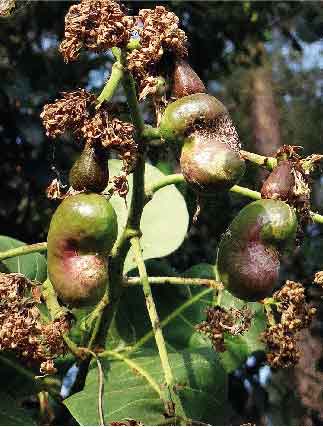
Import Cashew Nuts It is native to northeastern Brazil and within 10° south latitude. Countries with large cashew cultivation areas in the world include India, Brazil, Vietnam, Mozambique and Tanzania .
In China, cashew nuts are mainly distributed in Hainan and Yunnan. Guangxi, Guangdong, Fujian, and Taiwan are also introduced. [3]
Cashew Nuts Growth habit
Cashew nuts are highly adaptable, and are warm-loving and strongly positive tree species. It is resistant to drought and barrenness, and has certain wind resistance. It is appropriate to grow below 400 meters above sea level. The requirements on the soil are not high. In addition to the poor development of heavy clay and limestone, it can grow in red soil, sandy soil or stony mountain with less than 1% organic matter content. [3]
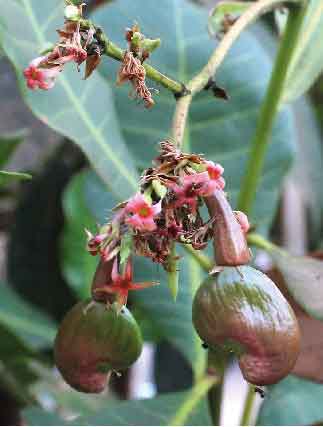
Import Cashew Nuts because are not cold-resistant and require very high temperatures during the growing period. The monthly average temperature is 23-30℃, and the flowering and fruiting are normal. The growth is slow at 20℃, lower than 17℃, and vulnerable to cold damage. If it is lower than 15℃, it will be seriously injured and die. The annual sunshine is more than 2000 hours, and the annual precipitation is preferably 1000-1600 mm. It should not be planted in areas where the groundwater level is too high or the water accumulates during the rainy season. Avoid rainy during flowering.
The growth period is generally in the early rainy season.
It blooms 2 years after planting, results in 3 years, and enters the fruit-bearing period after 8 years, and the fruit-bearing period is 15-25 years.
Cashew Cultivation Techniques
Due to the instability of the yield shape of the offspring of cashew fruit seedlings, asexual reproduction is mostly used . Asexual propagation techniques for cashew nuts include beading, cuttings, epicotyl grafting, inlaying, butting, budding, splitting, cutting, cork, tissue culture, etc.
Seed soaking with 30 mg/100 g of indole butyric acid ITT for 24 hours can increase the seedling rate by 61.11%; soaking seeds with warm water at room temperature 55°C for 24 hours can increase the seedling rate by 50%. In addition, soaking seeds with 60 mg/100 g of ITT for 24 hours and with 1/2 ADNK for 24 hours can also promote the germination of cashew seeds. Soaking seeds with 90 mg/100 g of naphthaleneacetic acid (NAA) for 24 hours has the best effect on promoting the high growth of seedlings. [3]
Cashew Bead
Cashew aerial stripping seedlings should be carried out from February to April or October to November each year, with the highest survival rate of more than 93%. The age of the beaded mother plant is preferably below 10 years of age. It can take root 35 days after beading and can be separated from the mother tree in 45 days. If the mother plant is over 20 years old, it is difficult to take root after beading. The materials used for the batten are peat, moss and shavings. Before propagating , the mother tree should be treated with 0.00025 g/ml of ethylene or 0.001 g/ml of chlormequat , and then with 0.003-0.005 g/ml of ITT and 0.0002 g/ml of p-carboxybenzyl group. , Can promote the roots of branches, increase the number of roots and root length.
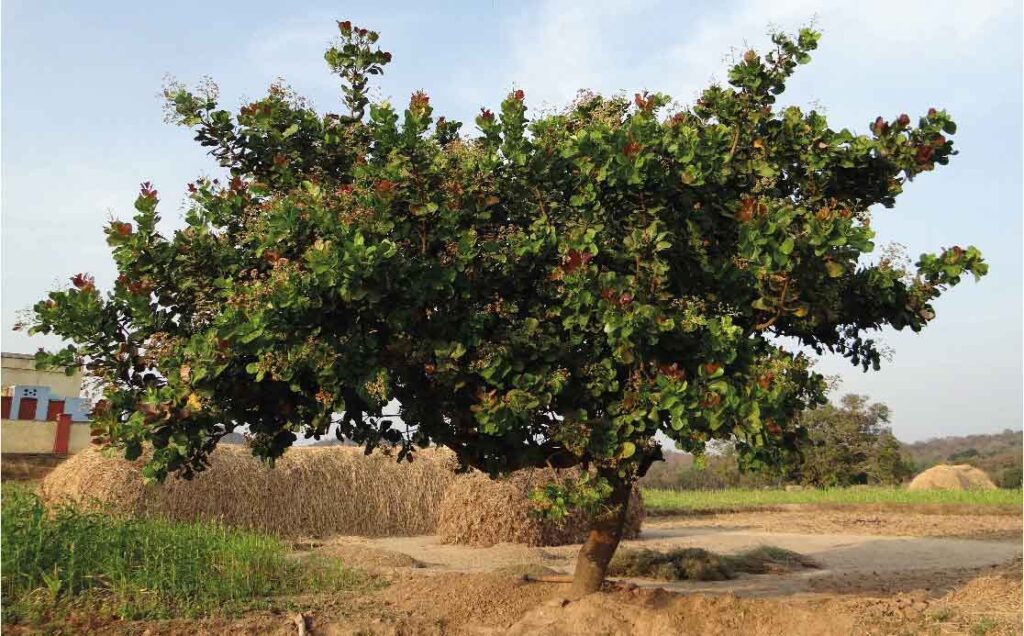
Cashew Tissue culture
Cotyledon explants cultured on medium supplemented with 0.5 mg/L IAA and 0.5 mg/L kinetin can directly form organs, and complete plants can be formed directly after about 5 weeks without further cultivation and rooting. [3]
Plastic pruning can adjust the crown structure, improve the ventilation and light transmission of the tree body, thereby increasing the fruit setting rate and increasing yield. Cashew young tree repair
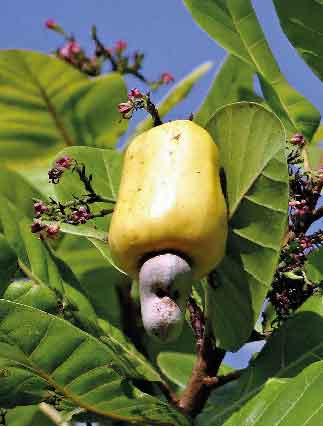
The principle of pruning is that it should be light, not heavy, early or not late, and the method of pruning multiple times in batches is adopted, and the pyramid shape pruning and shaping effect is good.
Cashew Fertilize
Although cashew trees are resistant to infertility and drought, cultivation practices have shown that cashew trees grown in natural conditions have almost no yield. The yield of mature fruit trees will be doubled after fertilization. From the perspective of fertilization types, N, P, K mixed application has the best yield increase effect; followed by single application of P, again N, P mixed application. Higher levels of N can extend the flowering period, while higher levels of P and K shorten the flowering period. Applying N600 grams, P200 grams, and K200 grams per plant per year can significantly increase the nut tree per plant and increase the total yield and kernel yield. [3]
Cashew Pest control
Cashews are harmed by more than 60 diseases and insects at different stages of their growth. Among them, the cashew nut diseases mainly include inflorescence blight, leaf blight, glue gum disease, branch rot and leaf decay disease, leaf rot disease, yellow leaf spot disease, leaflet disease, etc.; the pests mainly include cashew horn bug, cashew nut moth, cashew iron borer, Scarabs, etc.
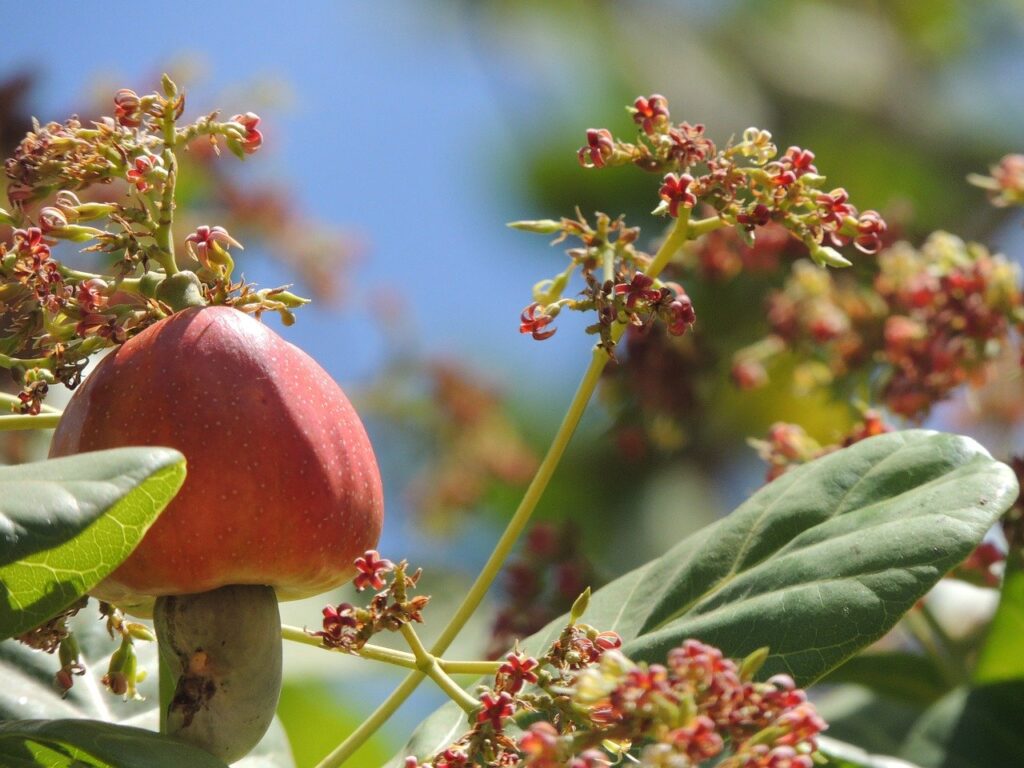
Cashew iron borer is a pest of cashew tree stems. The best way to control it is from July to August spawning period. Generally, 0.15% carbaryl or 0.05% long-acting phosphorus can be used to treat the bare roots of cashew trees.
Cockchafer larvae mainly harm the roots of cashew trees. The chemical control method is that the application of 1 kg of active ingredient per hectare stone sulfur mixture is the best.
Cashew Main Value
Cashew Medicinal
The flesh is crisp and tender and juicy, with a moisture content of 87.8%, carbohydrates 11.6%, protein 0.2%, fat 0.1%, and also contains a variety of vitamins and calcium, phosphorus, iron and other mineral elements, which has beneficial effects on water, dehumidification and swelling. It can prevent gastrointestinal diseases and chronic dysentery. [4]
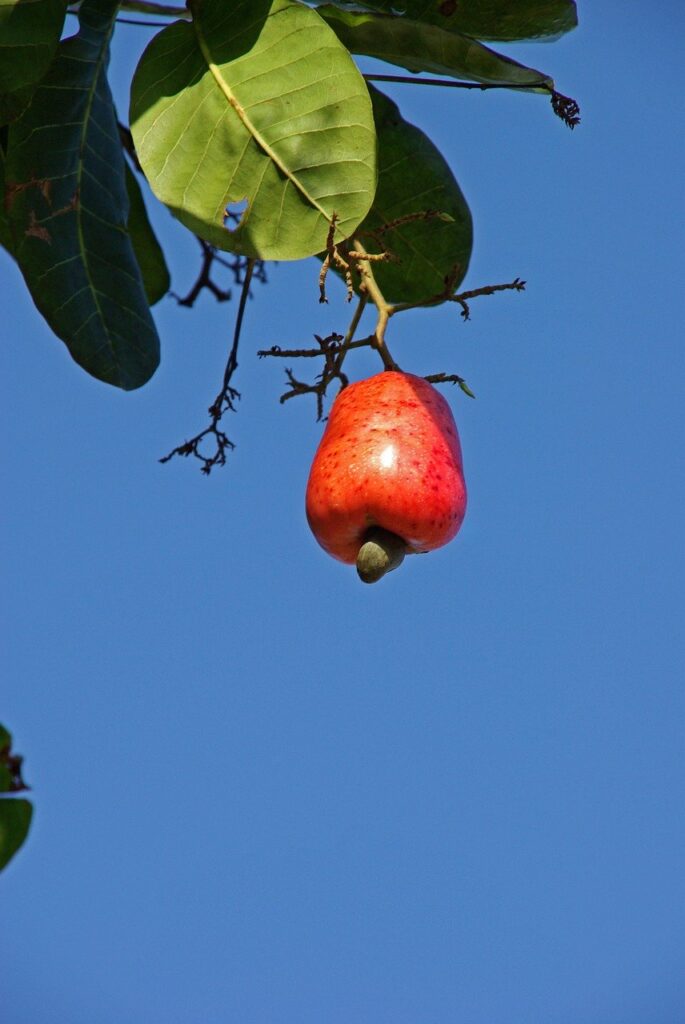
The real fruit is a kidney-shaped nut born at the top of the fake fruit, about 25 mm long, from greenish gray to yellowish brown, the shell is hard, and there are seeds in the bread. This is what we often say “cashew”. It is very rich in nutrients, including fat up to 47%, protein 21.2%, carbohydrates 22.3%, and still contains A, B1, B2 and other vitamins and minerals, especially trace elements such as manganese, chromium, magnesium, selenium, etc. , With antioxidant, anti-aging, anti-tumor and anti-cardiovascular effects. The fats contained are mostly unsaturated fatty acids, of which oleic acid accounts for 67.4% of the total fatty acids and linoleic acid accounts for 19.8%. It is a good dietary therapy for patients with hyperlipidemia and coronary heart disease. [4]
The content of vitamin B1 in cashews is second only to sesame and peanuts. It has the effect of replenishing physical strength and eliminating fatigue.
Cashew nuts also have the effect of promoting lactation , benefiting women with insufficient milk production after delivery.
contain a lot of protease inhibitors , which can control the cancer. Regular consumption of cashews has the effects of strengthening the body, improving the body’s resistance to disease, increasing libido, and increasing body weight.
Chinese medicine believes that cashew nuts are sweet, calm and non-toxic. It can cure cough, upset, and thirst. “Haiyao Materia Medica” Yiyun: The main irritability, distress, phlegm, typhoid fever, cough and qi.
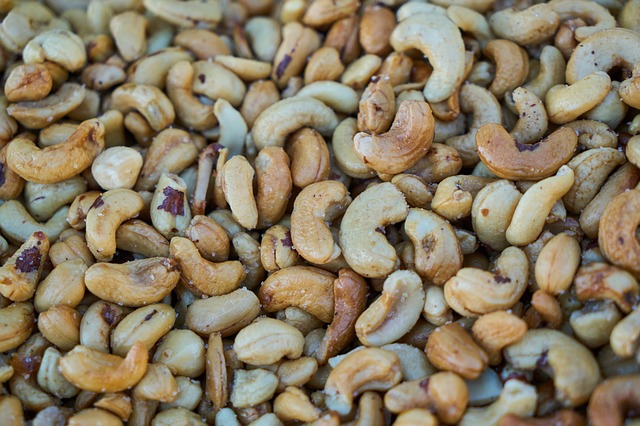
Import Cashew Nuts Nuts Edible
protein contained is generally twice as much as cereal crops, and contain an amino acid type and kind of amino acids complementary to the grain.
Cashew nuts are sweet, crisp and delicious. The most common is snacks like peanuts. The most common way to eat them is to eat them in rolling oil and pick them up immediately. , Is an ideal appetizer. For cooking, there are chicken with cashew nuts, shrimp with cashew nuts, yuba with cold cashew celery, fried scallops with cashew nuts, etc.
It seems not common to use cashew nuts to make soup, but for many vegetarians, cashew nuts are also very good soup ingredients, like peanuts and chestnuts . Such as vegetable cashew soup, pumpkin cashew soup, burdock cashew soup, lotus barley cashew soup, Tianma cashew mushroom soup and so on.
Import Cashew Nuts Toxic Plant
Its toxicity is poisonous peel and seed coat. Its water extract comes in contact with the skin and causes stinging, redness and blistering. Ingestion can cause tingling in the tongue and abdominal pain. Intravenous injection of water and alcohol extracts from the skin to anesthetized cats can lower blood pressure and have a strong toxicity to small fish.
Cashew nuts contain a variety of allergens, which may cause certain allergic reactions for people with allergies. Cashew nut shells are rich in fat, but this fat is toxic.
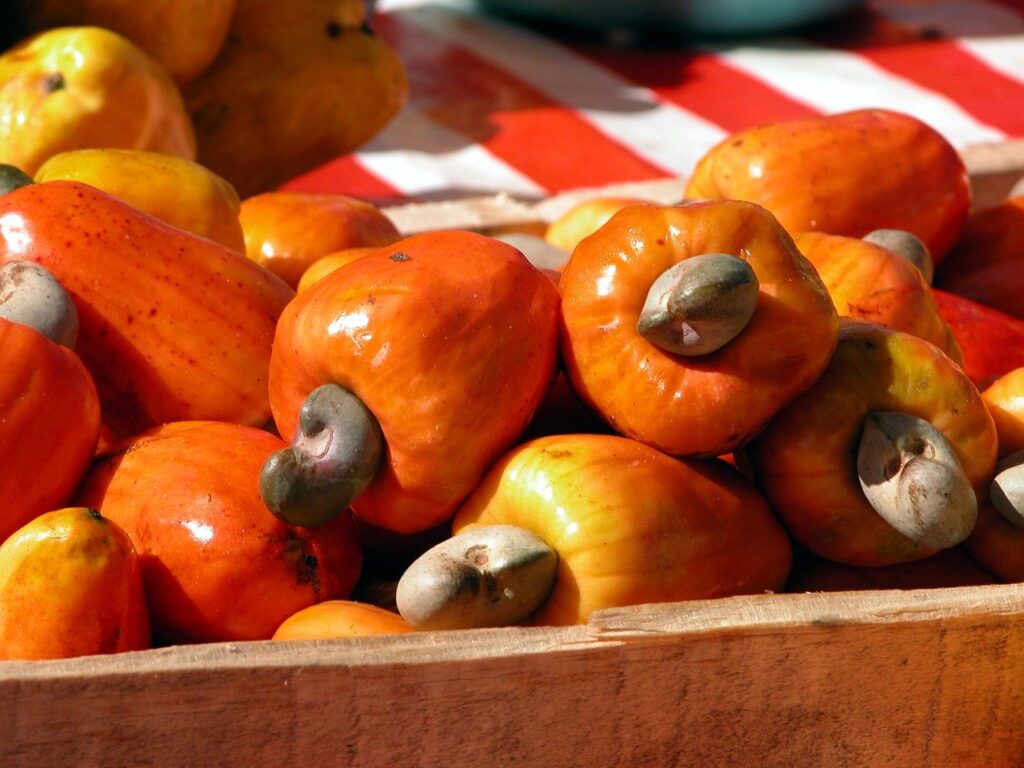
Cashews are delicious and delicious, and have a certain therapeutic effect. However, if you eat too much, some allergic symptoms will often occur. Those with mild abdominal pain, nausea, edema of the lips and eyelids, itching of the throat, itching of the eyes, ears, and nose, sneezing, runny nose, and dizziness; In windy groups, adults develop anaphylactic shock; the most dangerous is respiratory edema.
In particular, the original bronchial asthma will be more serious. During an asthma attack, the bronchial susceptibility to irritants increases. Certain ingredients in cashews can cause type I allergy in asthma patients, and then a series of clinical allergy symptoms. [4]
Cashew purchase
1. Choose a complete crescent shape, white color, fullness, fragrant smell, rich in oil, no moth or spots, and sticky hands or dampness indicates that the freshness is not enough.
2. It is best to soak the washed cashew nuts for 5 hours before use.
3. It should be stored in a tight jar, put in the refrigerator for refrigeration, or put in a cool place, ventilated place, avoid direct sunlight.
